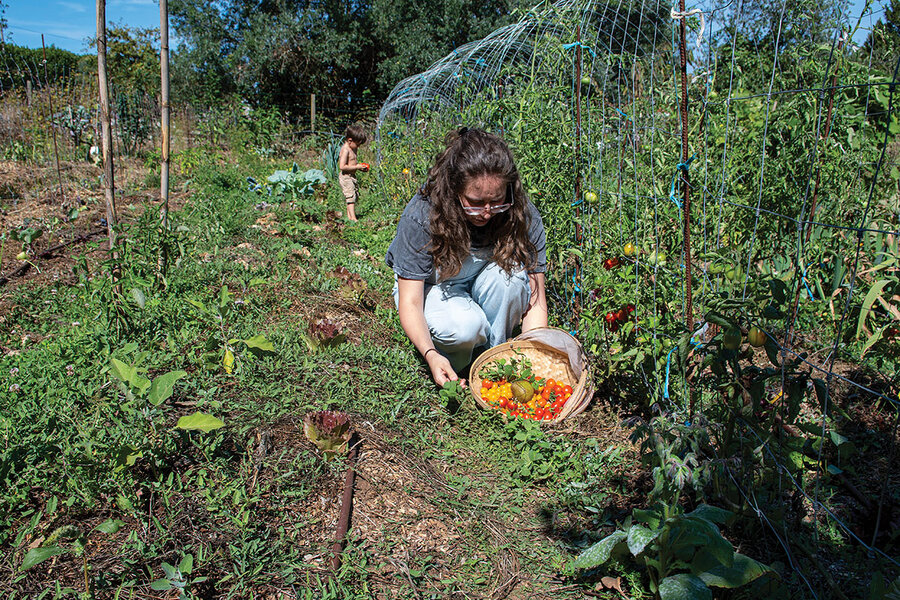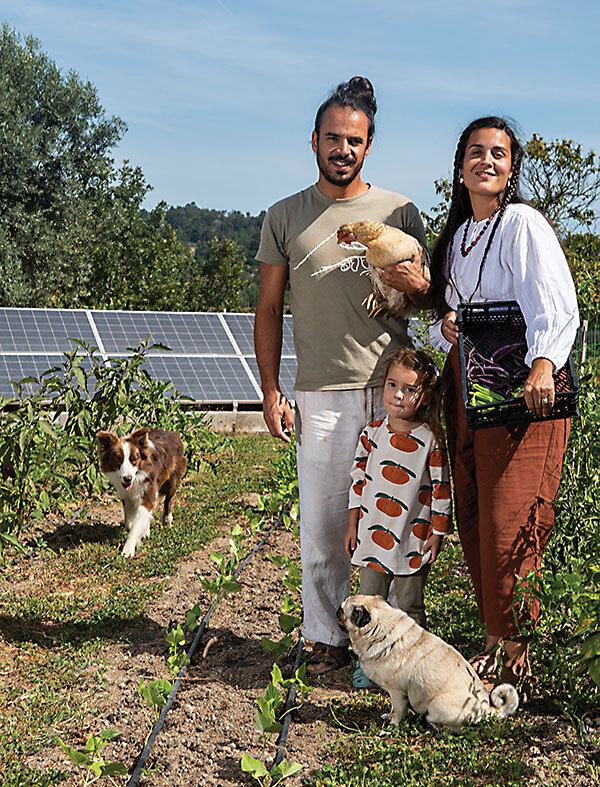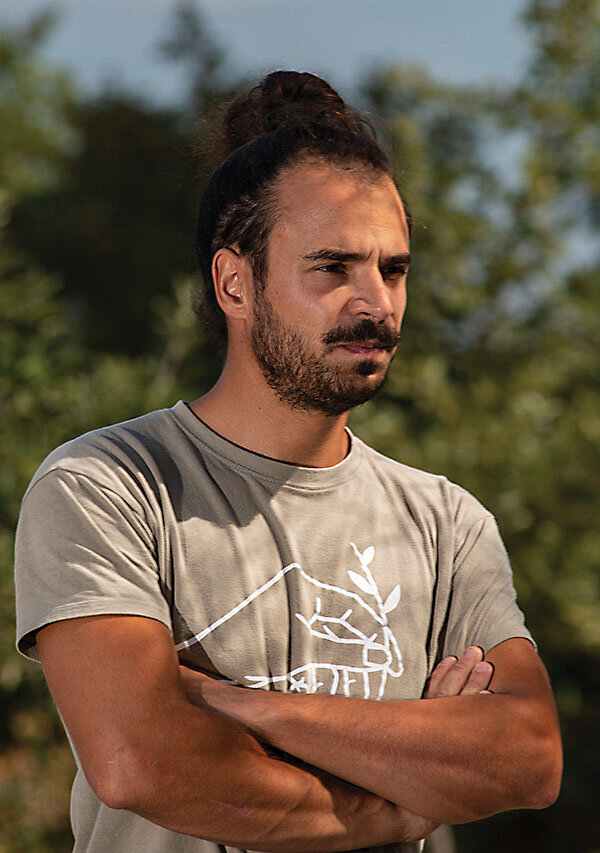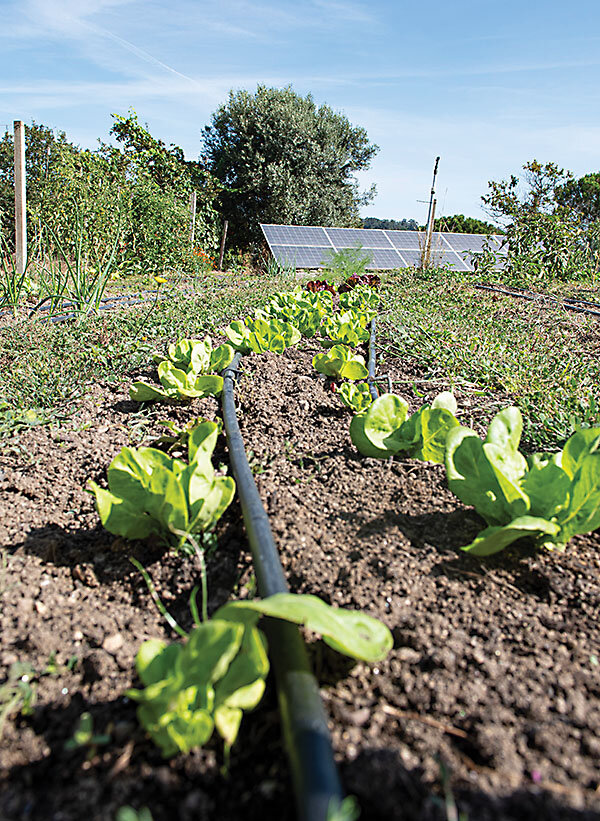In a return to forgotten lands, young farmers go small, demand less
Loading...
| Porto de Mós, Portugal
For Rute Gabriel and Pipo Vieira, who were living in Ms. Gabriel’s grandmother’s 25th-floor apartment in Toronto, it was the tomato plant on the balcony that convinced them to return to Portugal.
They’d emigrated from a rural Portuguese region, and they had safe jobs in the middle of the global financial crisis of the 2010s.
Why We Wrote This
A story focused onNew Portuguese farmers are proving that economics and ecology don’t have to conflict – agriculture can be small and natural, and produce an income. Part 6 in a seven-part series.
But the young couple missed the bright sunlight of home and had a growing unease about the heating world and what felt like an unsustainable lifestyle – in life and work, and between their lives and the environment.
Ms. Gabriel came across something called “permaculture” – an environmental and agricultural philosophy that reintegrates humans into their habitats in a way that’s mutually beneficial for people, the land, and animals.
That little tomato plant, they say, was a glimpse of what could be.
Farming has a low-status, low-income reputation in Portugal. But some in the Climate Generation – that cohort born after 1989 and into a world of accelerating impacts of a heating atmosphere – buck that view. In 2016, the couple moved back to the Portuguese countryside and an agrarian life.
“We take ourselves out of our habitat, and we wonder why we are struggling so much,” Ms. Gabriel says. “We realized we had to go back to the country.”
For Rute Gabriel and Pipo Vieira, it was the tomato plant on their 25th-floor balcony in Toronto that convinced them to return home.
The couple, sweethearts ever since high school in this Portuguese region of stone-fenced fields and olive groves, were sharing an apartment with Ms. Gabriel’s grandmother. Their friends back home thought they had hit the jackpot. They had managed to move from the country to the city. They had immigrated to a higher-income country. And in the middle of the 2010s, they had jobs at a time when the global financial crisis – known here simply as “the austerity” – was still hitting Portugal hard.
But the couple had a sense that something was wrong. They were in their 20s and working constantly in jobs they did not love. They missed the bright sunlight and rosemary-fresh scent of home, and had a growing unease about what felt like an unsustainable lifestyle – not only in their balance of life and work, but also in their lives and the
environment.
Why We Wrote This
A story focused onNew Portuguese farmers are proving that economics and ecology don’t have to conflict – agriculture can be small and natural, and produce an income. Part 6 in a seven-part series.
They say it was all anxiety-producing – spending days working for the next paycheck, running on a consumer treadmill, knowing the world was heating but feeling there was nothing they could do about it.
Then one day, browsing the internet, Ms. Gabriel came across a YouTube video about “permaculture.” An increasingly popular term in environmental, landscape, and agricultural circles, permaculture is a philosophy that focuses on re-integrating humans into their habitats in a way that’s mutually beneficial for people, the land, and animals.
Ms. Gabriel was fascinated, she recalls. This was the sort of lifestyle she and Mr. Vieira were craving.
They tried to implement bits and pieces of permaculture at their high-rise apartment, putting a little tomato plant on their balcony, and then trying out “companion planting,” in which they added peppers and carrots to the same container.
That little plant, they say, was a glimpse of what could be.
“We take ourselves out of our habitat, and we wonder why we are struggling so much,” she says. “We realized we had to go back to the country.”
So in 2016, they did what generations of young Europeans have avoided: They moved back not only to their homeland, but also to the countryside and an agrarian life. Their plan was to build a homestead and run Portuguese-language permaculture classes – to support themselves, to regenerate the land, and to help others create sustainable lifestyles.
Many of their friends thought they were crazy. Farming, once the occupation of nearly one-fifth of the Portuguese population, has a reputation as a low-status, low-income profession. For years, most young people born in agricultural areas have fled, to the point that Portuguese officials are scrambling to fix what is widely known as the “young farmer problem.” Over the past decades, some rural villages have dwindled to five, eight, or 20 people; schools have closed, and health clinics have shuttered. Portuguese farmers are the oldest in the European Union, with 51.9% above age 65, according to government data. Only about 6.4% are under the age of 40.
But some in the Climate Generation – as we’re calling the cohort that was born since 1989 and into a world of accelerating impacts from a heating atmosphere – are bucking this trend. Government data shows a small but clear uptick in young people entering the agricultural sector over the past few years. And some are coming back to rural areas in Portugal to intentionally step onto the front lines of their country’s climate struggle, trying out new methods of climate-friendly food production.
The full size of this movement is hard to quantify because many of these young people hold other jobs and may not identify themselves as farmers for government statistical purposes. But it is recognizable. From Barbados to Namibia to the United States, a large portion of the Climate Generation is focused on food – growing it, sharing it, and questioning the status quo approach to it.
This is in part because the Climate Generation knows that what we eat, and how we grow it, has huge climate implications. Everything from shipping feed to making fertilizer to throwing wasted food in a landfill contributes to greenhouse gas emissions. But by focusing on rebuilding soil’s natural fertility, “regenerative” farming practices can sequester carbon – a potential climate solution.
Young people recognize this. As part of a 2021 United Nations Food Systems Summit, officials polled thousands of young people about their attitudes toward food. Overwhelmingly, wrote UNICEF Executive Director Henrietta Fore, children understood the connections between food systems and climate change – both in how agricultural practices can exacerbate climate change and in how climate change is increasing droughts, reducing food nutrition, and, according to international scientists, threatening food security for huge swaths of the world.
But food systems reflect something even more for the Climate Generation. Food is a tangible, everyday doorway into larger questions about how we relate to the earth and how we consume and share resources. Look at food closely, and it illuminates questions about how and why we work. It brings a tangible practicality to philosophical theories – about whether we keep demanding more by expanding and growing, about modern consumption and lifestyles, about what it means to continue extracting from a planet showing its limits in the form of wildfires, droughts, storms, and heat waves.
To some in the Climate Generation who have decided to move, literally, closer to the food chain, the answers to these questions seem obvious.
“This is the future of humanity,” says João Rodrigues, a 34-year-old artist-turned-farmer, standing by his tomato plants in the interior of Portugal. “To go small.”
Local consumers willing to pay extra
Mr. Rodrigues and Raquel Silva purchased their hilly, 25-acre property outside the ancient interior Portuguese city of Viseu in 2017. The land had a decrepit stone barn, an oak forest, and a few small, uncultivated plots. The former owners had run a vineyard and cultivated pine trees. There was no electricity or running water. But the couple believed that, with regenerative practices, they could grow food on this land. At the time, they owned a design studio – a business they began shortly after graduating from an arts college outside Lisbon, where they had met. In 2019 they had their baby daughter, Teresa. And some months after, they moved into a camper on the farm. They added a stucco facade with blue shutters and a pavilion with an outdoor kitchen. This would be their temporary lodging until they finished building their house.
At first, the plan was to simply grow food for themselves, Ms. Silva says. But they soon realized that in a half-acre field, they couldn’t get enough food for a season; they’d have broccoli, say, for a few weeks, but no more. The next year, they tried planting another plot but quickly ended up with more food than they could eat themselves.
They didn’t want those vegetables to go to waste, so they took their extras to sell at their studio in Viseu. At first, they weren’t sure if they would have buyers. For them to break even, their food had to be priced higher than at grocery stores, where economies of scale and industrial agriculture allow for lower prices.
But it turned out there were many people in town who wanted to pay extra for something that tasted and felt better. They sold out quickly. The next year, they tried subscription boxes, eventually supplying food boxes to 20 families.
Soon, they were earning more from farming than from their studio. They decided to shift into full-time agriculture, although they still maintain their Etsy shop and their storefront.
They regularly get inquiries from people hoping to be part of their CSA, or community-supported agriculture, plan. But they don’t want to get too big. They believe the best way to create a sustainable food system is to have many small farmers supporting small groups of nonfarmers – a connected web that will prove resilient even if larger systems collapse.
This is not just theoretical, Ms. Silva says. Inflation, plus the food price fallout from the war in Ukraine, reveals “the tip of the iceberg on how climate change will affect the food supply all over the world,” she says. “This approach that we have can really help in the bigger picture to reduce some of the effects of climate change. And we do think that having a big chunk of food coming from local sources is key to having a very strong food supply chain, and also having food sovereignty.”
A different approach to agriculture can be a climate solution
The impact of climate change on agriculture is particularly clear in Portugal.
Over the past decade, the country has faced increasing droughts, wildfires, and heat waves. This has been especially true in the rural, sparsely populated interior regions, home to most of Portugal’s farmland. Fewer residents means that wildfires can erupt and burn longer without being noticed. And according to the Universidade Nova de Lisboa’s Platform of National Desertification Observatory, more than 54% of the country is vulnerable to desertification, which is when soil becomes so parched and degraded that it cannot support plant life.
“Once I said on social media that this is the worst time to start a farm because of climate change,” says Ms. Silva. “Last year we had the driest year since the ’30s – so the worst drought in 100 years.”
Indeed, according to the Portuguese Institute for Sea and Atmosphere, nearly 90% of Portugal was suffering from drought in April of this year, with 34% experiencing “extreme” or “severe” drought. That means chalky gray soil and dying citrus trees, shriveled winter grain and farmers selling livestock they can no longer feed.
The Intergovernmental Panel on Climate Change (IPCC), a U.N.-supported project of thousands of researchers from around the globe who summarize the existing scientific understanding of climate change, says one of the most serious impacts of a heating world will be the effect on agricultural systems. (That’s even beyond extreme weather events and habitat.) This is particularly true in sub-Saharan Africa and Asia, but Europe is impacted as well. Climate change is resulting in everything from decreasing land productivity to seed viability, according to the scientists. A 2019 report from the Global Commission on Adaptation forecast that global food yields will decrease between 5% and 30% by 2050, while food demand increases.
Part of the problem, scientists point out, is that agriculture is accelerating its own demise.
For years now, the public conversation around climate change solutions has primarily focused on changing energy sources – shifting from coal to solar, for instance, or from gas-powered vehicles to electric cars. Agriculture, though, is also a huge greenhouse gas contributor. Along with other land-use and forestry sectors, it’s responsible for up to a fifth of all warming, according to the IPCC.
Industrial agriculture is particularly tough on the climate because it requires fossil fuel-based pesticides and fertilizers. Shipping food or livestock feed around the world also results in heat-trapping gases going into the atmosphere.
But a different sort of agriculture can be a climate solution. Regenerative agriculture, like the sort Ms. Silva and Ms. Gabriel practice, can rebuild the soil structure that captures carbon from the atmosphere. Local food has a dramatically lower carbon impact than food shipped long distances. Increasing numbers of organizations, from the climate change-focused Project Drawdown to the World Bank, have started to encourage regenerative agriculture as a climate solution, and industry organizations have predicted a significant increase in the market for regeneratively farmed products. (One group, Research and Markets, believes the European regenerative agriculture market will see a 14% increase annually from 2023 to 2029.)
Because of this, a growing number of farmers, particularly younger ones, are starting to see themselves as a key part of a global solution.
“There’s been a really kind of dramatic change in the way that farmers see what agriculture can do,” says Jules Pretty, professor of environment and society at the University of Essex in England.
But the thing about regenerative practices – farming that rebuilds ecological health even as it harvests – is that they’re nearly impossible to do at a large scale. Industrial agriculture is built to go big. That means long rows of single crops that allow for high-tech automation and big farm equipment, chemical inputs like pesticides and synthetic fertilizers that increase yields, and economies of scale that keep prices low.
Regenerative agriculture, on the other hand, attempts to rebuild ecosystems in a way that integrates the various plants, animals, and microbes that naturally exist in a specific place.
But while supporters say that healthy ecosystems are far more resilient than monocultures, they’re often not, in the language of modern-day economics, efficient.
The typical argument against small-scale regenerative farming is that while it is good for the environment, it doesn’t actually feed societies fully and replace the calories provided by an agro-industrial sector. And, critics say, food grown this way tends to cost more.
But that, according to many in the Climate Generation, is the wrong debate.
Inês Costa Pereira is a landscape architect and Portuguese advocate for agroecology, which applies sustainable ecology principles to agriculture while supporting local environments, small farms, and native animals and plants. She sees a new sort of philosophy emerging among the new young farmers. The Climate Generation is not trying to just swap out existing grocery store fare with better, local food, she says. It’s trying to get people to re-imagine the way their lives are connected to land, she says. That means people consuming less of what they don’t need – more clothes, bigger houses, fuel-guzzling cars – so they can focus more on what is essential, such as community, good food, deep connections, and nature. This is not going back to preindustrial living, she says. Many regenerative farmers use technology, from solar power to high-tech greenhouses. But it does require a reorientation of values.
“Cheaper and easier has been a goal for a long time,” she says. “But having less is what we need to do.”
She and others are quick to note that this doesn’t mean going hungry. It means perhaps living differently, eating locally, and spending more money on food. It means, for young people in cities, starting urban farms, food-waste reduction programs, and other projects intended to make full use of the food resources that exist. And it often means creating community around these shared values – whether it is connecting to the aging, traditional farmers who still hold much agricultural knowledge, or connecting across professions.
In the rural town of Montemor-o-Novo, for instance, a group of young farmers and professionals has formed a cooperative called Minga, which basically means “de-growing.”
Their idea is to push back on the economic idea that links progress to expansion. Instead, the cooperative connects farmers to craftspeople, and young artists to farmers. And it gives a setting for local producers to sell wares and support each other in a circular economy – an approach of sharing and reusing that values time and connection over money.
Many of the members are in their early 30s.
“We can choose our values, and how to live with them,” says cooperative spokesperson Marília Moura. “The nature model is really important as an inspiration for how we can work together. Nature knows how we can cooperate.”
Similar initiatives have started cropping up across the country. The challenge now, Ms. Moura says, is that so many young people want to join, there is a need to split co-ops into multiple organizations or chapters in order to keep the groups relatively small. These co-ops can include everyone from lawyers and architects to farmers and chefs. The idea is not a vow of poverty, those involved insist – it’s a re-prioritization of when to focus on money, and when to look to other priorities.
“All the time, people are arriving to this movement,” she says. “People’s hearts are opening. They see what is happening to the land; they see what is happening to the climate, the water. It gives us hope that we will do our best to protect life – to show that it’s possible to live healthily and happily and connected and in a respectful way. ... We don’t need so many things.”
A new narrative of how to live the best life
It's natural that young people, confronted by the realities of climate change and the anxiety that often accompanies it, are turning to new narratives about how to best live, says Dr. Pretty, who also directs his university’s Centre for Public and Policy Engagement. He focuses much of his research on the stories people tell to understand their environments – and how they can transform narratives to build hope and resilience.
“People would call us crazy because we came back from Canada,” recalls Ms. Gabriel. “They said, ‘Oh, you could have made so much money!’ I remember someone saying to me [about our permaculture project], ‘That’s too romantic. You have to do something practical.’”
She gestures to the water collection system that she and Mr. Vieira have installed to trap rainwater running off their house: “This is super practical.”
Before she began investigating permaculture, Ms. Gabriel had no agricultural background. Mr. Vieira, as a boy, had helped his father, who had a home garden and a few animals. But today, they have created a tapestry of food in the backyard of their home, with avocados and plum trees and leafy greens and herbs. (Her parents, who are retired and travel regularly, invited the couple to move in with them, something Ms. Gabriel and Mr. Vieira see as part of their community-oriented living.)
Nearby, the tomato plants are ready for harvest. The gooseberry bush is exploding with bright yellow fruit, and their 3-year-old son, Isaac, skips barefoot to investigate a pear tree that flowers next to kale, carrots, lemon balm, and strawberries. A neighbor has dropped off cheese she made from her own cow’s milk, along with a loaf of farmer’s bread – not as any form of barter or trade, just as a form of community care that exists in this part of the country. Ms. Gabriel asks if anyone would like any homemade ginger ale – one of her newer projects. Mr. Vieira gently rocks their baby, Noah, who has fallen asleep in his arms.
Sure, there are some days he doesn’t feel like working in the garden, or running another permaculture class online, he says. It’s not that everything is easy and perfect all the time. But this way of life, with lower expenses, greater proximity to the food chain, more independence – it all feels right, he says.
“Quality of life can be hand in hand with a positive change when it comes to climate change,” he says. “It used to be ecology versus economics. Now people realize it doesn’t have to be that way. Instead of being exploited and exploiting nature, we can live differently.”
This message has an appeal. In the year since they started their permaculture classes, they have had more than 2,500 students, and they say interest is still growing.
Ms. Silva also notices the attraction people seem to have to her and Mr. Rodrigues’ work.
When they first moved to the land that would become their farm, she began documenting the land’s transformation on Instagram. She is a designer, after all, so she enjoys visual media. And from selling their studio wares online, she and Mr. Rodrigues had a good idea of how to take photographs to make carrots and kale look beautiful.
Soon her account began attracting followers – more than 13,500 now – and many have asked her about starting their own farm projects in the Portuguese countryside.
She’s quick to tell them there’s a lot more to this than pretty Instagram pictures. It’s exhausting running a farm, she says with a laugh. But she tries to be encouraging to those who seem interested in taking a step toward a different way of life.
So do Ms. Gabriel and Mr. Vieira.
“There are a lot of young people who want this, but they are trapped into thinking that they need to get a job to have things,” says Mr. Vieira. “But more are realizing that they have choices.”





















